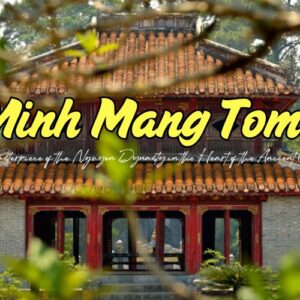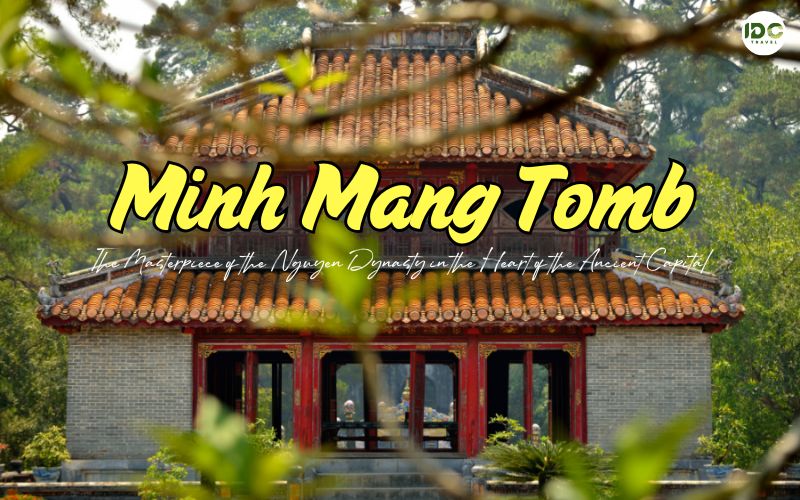
Hue, a quiet place, where time seems to slow down in each mossy tile roof, each breath of the Perfume River. In the heart of the ancient capital, the Nguyen Dynasty tombs are still majestic, telling stories of a glorious time. Among them, Minh Mang Tombs stands out with its harmonious beauty between architecture and nature, bearing the mark of a wise ruler. Read this article to explore the tomb in a comprehensive way.
Overview of Minh Mang Tomb
History of Minh Mang Tomb
Minh Mang Tomb, also known as Hieu Lang Mausoleum, is the resting place of the second king of the Nguyen Dynasty – Minh Mang Emperor. Located about 12 km from the center of Hue city, amidst the Cam Khe Mountain, near the Bang Lang junction, where the confluence of the Huu Trach and Ta Trach rivers forms the poetic Perfume River.

An overview of Minh Mang Tomb
Minh Mang Emperor, whose real name was Nguyen Phuc Kham, ascended the throne in 1820 and reigned until 1841. He was known as a king with great merits in expanding the frontier and reforming the country. After seven years of reign, the king began to have people to look for places to build his mausoleum. After 14 years of searching, Cam Khe Mountain was chosen as the place to build the mausoleum. In April 1840, construction began, but in January 1841, King Minh Mang passed away when the mausoleum was not completed. Thieu Tri Emperor continued the work and completed it in 1843.
Structure of Minh Mang Tomb
Minh Mang Tomb is a large-scale architectural masterpiece consisting of 40 large and small works. It is located in a hilly area with cool rivers and lakes. The whole tomb is like a human body lying on its head on Kim Phung Mount; its legs stretch out to the river junction in front of it. The two halves of Truc Minh Lake are like natural surrendered arms.
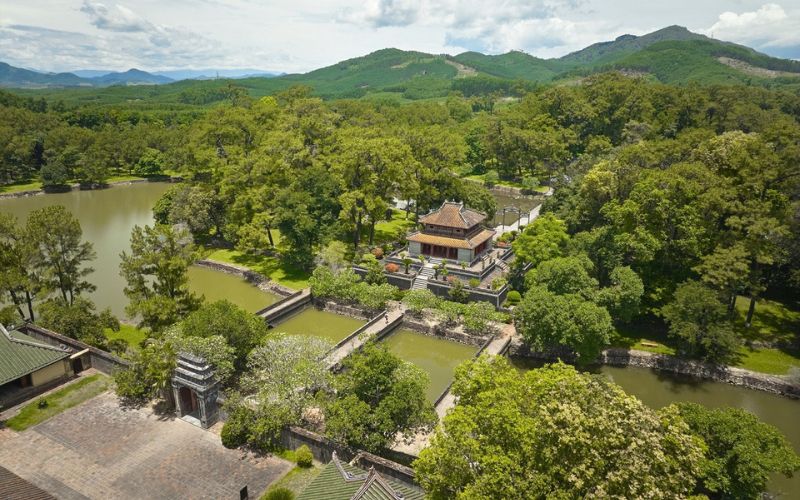
Minh Mang Tomb on Kim Phung Mount
When passing through Dai Hong Mon Gate, the main gate of the mausoleum, visitors will come to Bai Dinh, a large courtyard paved with Bat Trang bricks, where two rows of mandarin statues, mandarin, and stone horse elephants stand in adoration. At the end of the courtyard is Bi Dinh, where the “Holy Spirit” stele records the biography and merits of Emperor Minh Mang. Next, Hien Duc Gate leads into the main palace with Sung An Palace – the main place of worship. Across the Middle Way Bridge is the Minh Lau floor, an eight-tiered square architecture, considered a place for the emperor to rest and relax. Finally, Buu Thanh, the resting place of the emperor, is located in the middle of a clear blue lake, creating a peaceful and solemn scene.
Minh Mang mausoleum is not only the resting place of a talented king but also a unique work of architectural art, blending nature and people, showing the philosophy of life and aesthetic thinking of the ancient Vietnamese.
Things to Do in Minh Mang Tomb
When visiting Minh Mang Tomb, you can follow a route to explore completely the hidden charm of the tomb. This route starts from the exterior, where you can enjoy the tranquil natural scenery, and then you will come inside and admire the sacred architecture of the mausoleum.
Arrive at Dai Hong Mon Gate: The gate opens to the past
Stepping through the Dai Hong Mon Gate seems like touching another layer of space – where time stands still, and the past is present in each mossy stone. The gate stood tall, tinged with royal colors, with three paths of its own significance: the main gate for the king, and two auxiliary paths for officials. In the past, this gate was only opened once to process the King’s body into the mausoleum, keeping the solemnity. Standing in front of the Dai Hong Mon Gate, taking a deep breath, you will feel the majesty of the royal place, as if the footsteps of the old days still echo somewhere.
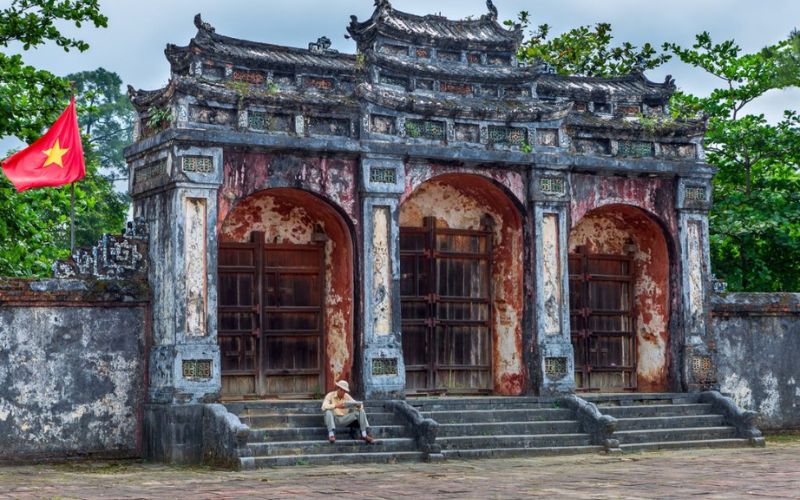
Dai Hong Mon Gate
Walk on Bai Dinh: The Corridor of Memory
Passing through Dai Hong Gate, you will arrive at Bai Dinh – a spacious, tiled courtyard of Bat Trang, where the mandarins and stone statues of horses, and elephants stand in a serious posture. This statue is not only a sculpture but also a metaphor for the loyalty and support of the king to the final resting place. Walking slowly in the middle of this yard, you see the silhouette of an old dynasty, where the officials bowed down to a wise man. Don’t rush ahead – let your heart settle, and feel the sacredness of history flowing in space.
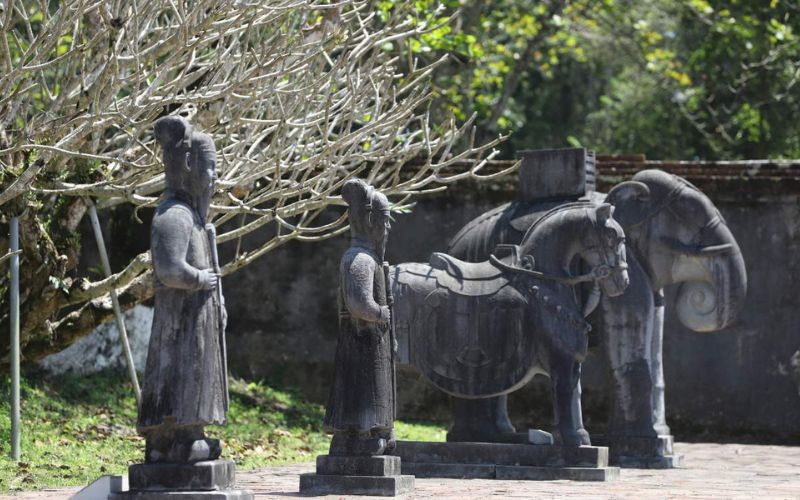
The statues of mandarins, horses, and elephants in Bai Dinh Courtyard
Visit Bi Dinh: Read the historical pages carved in stone
Located at the end of Bai Dinh courtyard is Bi Dinh, where the stele “Holy Spirit” records the feats, merits, and virtues of Emperor Minh Mang. The massive steel and the Chinese characters carved are sharp, still intact after many years. This is not merely an inscription, but a living history of the king who has done a great deal to expand the territory and reform the country. Let’s stand here for a moment, silently watching the dragon writing and phoenix dancing, to see that the past is not only in books but still visible right before our eyes.

The historical page carved in stone at Bi Dinh
Pass through Hien Duc Gate: Enter the spiritual space
When passing through Hien Duc Gate, you will enter the palace – the main place of worship of the mausoleum. Standing in front of the Sung An Palace, it felt like touching the breath of the past. The shimmering wooden pillars painted with yellow lipstick, the curved roofs like birds flying to the blue sky, all create a space that is both dignified and quiet. This place has witnessed many times the smell of smoke, and many vows and aspirations of a golden age that have fallen away. If you are lucky enough to come in the early morning, you will see the first rays of sunshine through the tile roof, creating a scene that is both fanciful and peaceful.
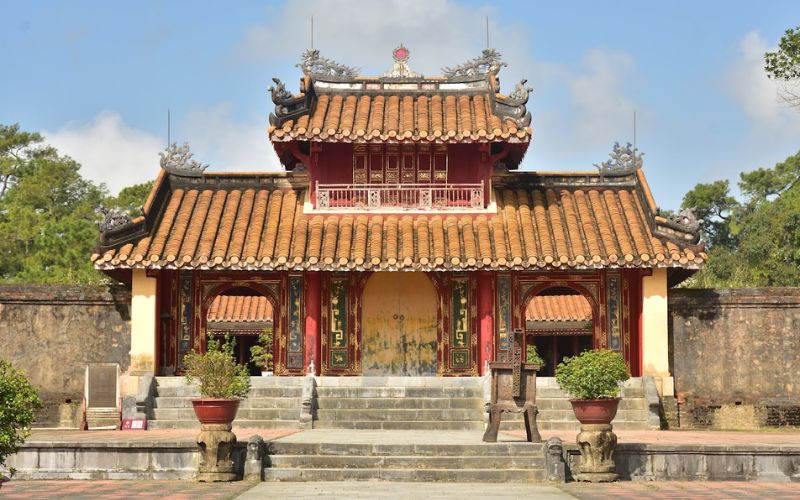
Hien Duc Gate
Visit Minh Lau Pavilion: Listen to the breath of nature
Going deeper into the mausoleum, you will come across Minh Lau Pavilion, a unique two-story, eight-roofed building located in the middle of lush green nature. The architecture here symbolizes the wisdom of the king, which is also the place where he once wished to rest and reflect on the world. Just standing upstairs, looking away, you will see a clear lake, and rolling mountains, a scene that makes people’s hearts soften. The wind gently drifts through the trees, bringing steam from Truc Minh Lake, creating a feeling of coolness and serenity. This is the ideal stopover to enjoy the harmony of architecture and nature.
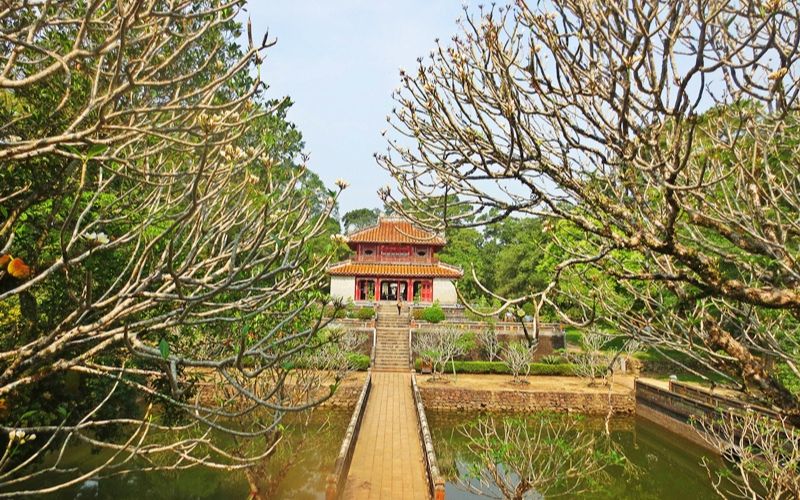
Minh Lau Pavilion
>>> Please visit our Enchanting of Hue in 4 days tour to visit all highlights of this poetic ancient capital.
The Trung Dao Bridge: The bridge between the real world and the dream world
To reach the resting place of Minh Mang Emperor, you must cross the Trung Dao Bridge, an elegant stone bridge across the clear blue lake. This bridge is not only a physical path but also a symbolic one, as a bridge between the earth and eternity. When walking on the bridge, walk slowly, watch the ripples under the water, and listen to the wind blowing through the trees, as if the sky is telling you old stories.
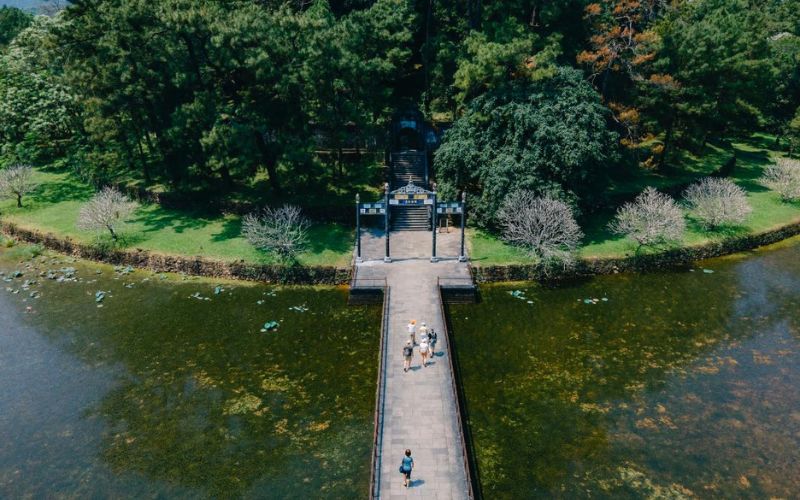
Trung Dao Bridge
Explore Buu Thanh: The place where a king sleeps
After crossing the bridge, you will arrive at Buu Thanh, the resting place of Minh Manh Emperor. The mausoleum is located in the middle of a quiet lake, surrounded by lush green trees, creating a feeling of peace and tranquility. This is the most sacred place in the whole mausoleum, a space where even the birds sing more quietly. Standing in front of Buu Thanh, you will feel the majesty but not compassion, but a gentle serene rest, as if the emperor was in harmony with the vast nature.

Buu Thanh
Tan Nguyet Lake: Lost in the watercolor painting
Surrounded by the tomb is Tan Nguyet Lake, the water’s surface reflects the sky, creating a picture-like scene. The lake water is clear, reflecting the ancient branches and the roofs are curved, creating a poetic beauty. Walk slowly along the lake, listen to the rustling leaves, and watch the lotus flowers quietly bloom on the water to indulge deeply in the tranquil atmosphere. This place is not only a part of the mausoleum architecture but also a symbol of the harmony between people and nature.
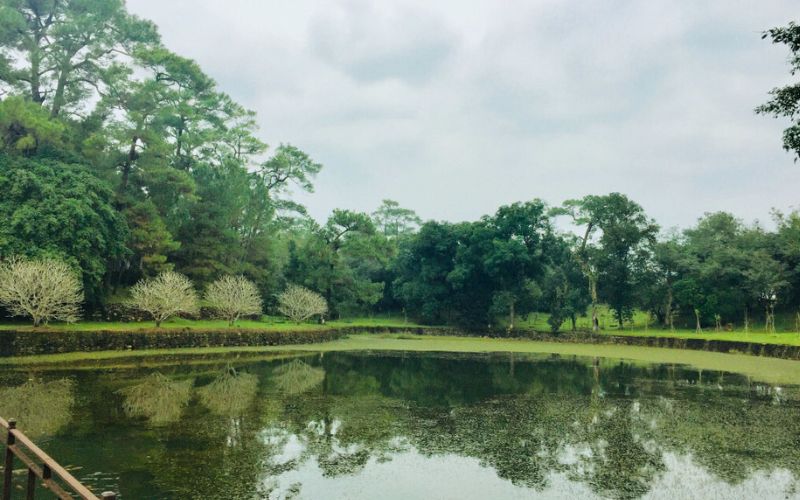
Tan Nguyet Lake
How to get there?
Minh Mang Tomb is about 12 km from Hue city center. Since the road is quite convenient, getting there is so easy. For those who love the sense of excitement and freedom, the motorbike is an excellent choice. You can rent one with the price range from 120.000 to 150.000 VND/day. If you travel by group of friends and family, a private car or taxi is a great option. It costs from 150.000 to 200.000 VND/trip. Lastly, for those who are seeking a unique experience, opt for boating a dragon boat on the Perfume River. You can start your journey from Toa Kham wharf and combine it with a visit to other tombs.
Helpful information for Tourists
- Opening hours: 7:00 am – 5: 00 pm every day.
- Entrance fee: 150,000 VND for adults and 30,000 VND for children. If you want to visit other tombs, please visit the official website to book tickets.
Visiting Minh Mang Tomb, there are some things you should note down to ensure a smooth and enjoyable experience:
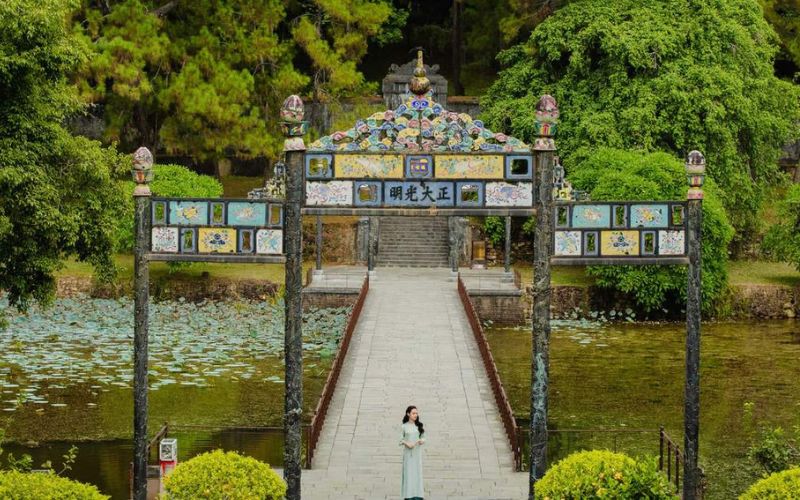
Taking photo with ao dai at Minh Mang Tomb
Firstly, it is crucial to dress modestly and respectfully. Visitors should not wear revealing clothes to show respect to the Emperor and local culture as well. In addition, since the tomb is large and you have to walk a lot, remember to wear a pair of comfortable shoes. If you want to take beautiful pictures in the tomb, consider renting ao dai or ancient clothes to fit the sacred vibe there.
Secondly, visitors should protect their skin from UV rays. Hue weather can be hot and sunny, especially during summertime, therefore, a hat, umbrella, and sunscreens are important items that can not missed.
Finally, it is recommended to visit nearby attractions such as the Perfume River, Dong Ba Market, Truong Tien River, and Thien Mu Pagoda. Combining these attractions with your visit to Minh Mang might give you a glimpse into the lyrical and poetic beauty of Hue City. It is also great if you visit somewhere in the vicinity of Hue, such as Da Nang and Hoi An; both of them are famous tourist destinations in Vietnam. If you love this idea, please reach out to our Best Da Nang & Hoi An City Daily Tour for 2025/2026.
In conclusion, the Minh Mang Tomb is not only a resting place of the Minh Mang Emperor but also a beautiful picture of the blending of architecture and nature. In the heart of the old capital, Minh Mang Tomb quietly tells the story of a golden age. If you are in love with the beauty of Hue and want to visit this stunning city, please contact us for dedicated assistance!
Read more:

